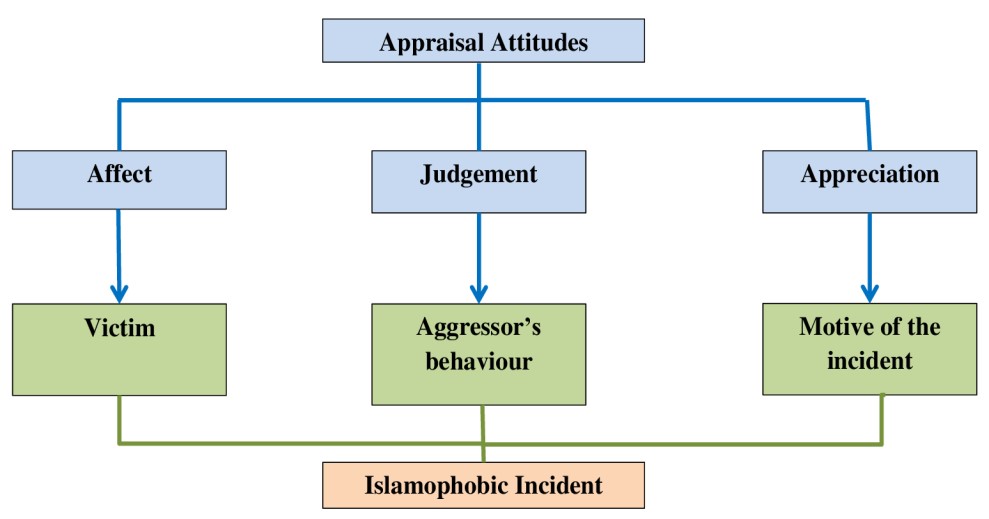Linguistic Evaluation of News Reports on Islamophobic Incidents
Abstract
This research paper aims at figuring out the way in which the world perceives the Islamophobic incidents. Such a global perception can be obtained from employing a kind of pervasive discourse that is emitted from global institutions and directed to the world in general. Thus, the conducted linguistic evaluation has targeted the news reports as a kind of global media discourse. The linguistic theory employed for language evaluation is Martin and White’s (2005) theory of appraisal. Three categories are classified in the appraisal theory: attitude, engagement, and graduation. Attitude is subdivided into effect, judgment, and appreciation; engagement into monogloss and hetergloss, and graduation into force and focus. The methodology works on three variables in the Islamophobic incident: the aggressor, the victim and motive. The orientation of investigation works to identify the attitude of affect directed from the report towards the victim, judgement towards the behavior of the aggressor, and appreciation towards the motive of the incident. The research also identifies the features of these attitudes as being negative or positive, the types (sub- classifications), engagement (monogloss or heterogloss), and graduation (force and focus) of the spotted attitudes. The data consists of twelve news reports selected, according to their topic, from three News agencies: BBC, Independent, and Fox News. The analysis has revealed that, contrary to many claims, news reports tend to adopt a neutral stance towards Muslims and Non- Muslims. They tend to portray the Islamophobic incidents as close to reality as possible.
Downloads
References
Alia, V., & Bull, S. (2005). Media and Ethnic Minorities. Edinburgh: Edinburgh University Press.
Allen, C. (2010). Islamophobia. Farnham : Ashgate.
Bednarek, M. (2006). Evaluation in Media Discourse. Analysis of a Newspaper Corpus. New York: Continuum.
Burak, B. (2018). Media Discourse ,Ideology and Print Media in Turkey. e-Journal of New Media, 2(2), 53-62. https://doi.org/10.17932/IAU.EJNM.25480200.2018.2/2.53-62
Crystal, D. (2008). A dictionary of linguistics and phonetics. Oxford: Blackwell. https://doi.org/10.1002/9781444302776
Danesi, M. (2009). Dictionary of media and communications. New York: Sharpe, Inc.
Elahi, F., & Khan, O. (2017). Islamophobia: Still a challenge for us all, A 20th-anniversary Report, Runnymede: Intelligence for a Multi-ethnic Britain. Retrieved from https://www.runnymedetrust.org/uploads/Islamophobia%20Report%202018%20FINAL.pdf
Elgamri, E. (2008). Islam in the British Broadsheets: The Impact of Orientalism on Representations of Islam in the British Press. Reading: Ithaca Press.
Eric, W. (2016). “How Can We Fight Islamophobia in America?” Ford Foundation, March 7, 2016, https://www.fordfoundation.org/ideas/equals-change-blog/posts/how-can-we-fight-islamophobia-inamerica/
Fowler, R. (1991). Language in the news: Discourse and ideology in the press. New York: Routledge. https://doi.org/10.2307/415093
Grazia, B. M. (2014). Introducing the Language of the News: A student’s guide. New York: Routledge.
Green, T. H. (2015). The Fear of Islam: An Introduction to Islamophobia in the West. New York: Fortress Press. https://doi.org/10.2307/j.ctt12878h3
Hall, S. & Gieben, B. (eds.) (1992). Formations of Modernity. Polity Press: Cambridge.
Hall, S. (ed.) (1997). Representation: Cultural Representations and Signifying Practices. SAGE Publications: London.
Halliday, F. (1999). 'Islamophobia' reconsidered. Ethnic and Racial Studies, 22(5), 892-902. http://doi.org/10.1080/014198799329305
Hart, C. (2014). Discourse, Grammar and Ideology: Functional and Cognitive Perspectives. London: Bloomsbury.
James, Poniewozik (2017). ‘“24: Legacy,’ A One-Hour Super Bowl Ad for Islamophobia,” New York Times, February, 6, 2017. https://www.nytimes.com/2017/02/06/arts/television/muslimterrorists-24-trump.html.
Kress, G. (1985). Linguistic Processes in Sociocultural Practice. Victoria: Deakin University Press.
Martin, J. R., & Rose, D. (2003). Working with discourse: Meaning beyond the clause. London: Continuum Press
Martin, J. R., & White, P. R. R. (2005). The Language of Evaluation: Appraisal in English. New York: Palgrave Macmillan Ltd. https://doi.org/10.1057/9780230511910
Mei, Z., Zhang, R., & Yu, B. (2015). An Appraisal Analysis of Reports about Chinese Military Affairs in the New York Times. In Zou B., Smith S., Hoey M. (eds.) Corpus Linguistics in Chinese Contexts. London: Palgrave Macmillan, pp. 178- 200. https://doi.org/10.1057/9781137440037_10
Ryzik, M. (2016). “Can Television Be Fair to Muslims?” New York Times, November 30, 2016, http://www.nytimes.com/2016/11/30/arts/television/can-television-be-fair-to-muslims.html.
Nawaz, S., Bilal, H. A., Kalsoom, M., Fayyaz, Z. & Nayyar, H.( 2013). Media Discourse and Their Implicit Ideologies. Asian Journal of Social Sciences & Humanities, 2(2), 328-337.
Nordlund, M. (2003). An essay of Linguistic Manipulation: An Analysis of How Attitudes are Displayed in New Reporting. Lulea: University of Technology.
O'Keeffe, A. (2006). Investigating Media Discourse. London: Routledge. https://doi.org/10.4324/9780203015704
Powell, K. A. (2011). Framing Islam: An Analysis of U.S. Media Coverage of Terrorism Since 9/11. Communication Studies, 62(1), 90-112. https://doi.org/10.1080/10510974.2011.533599
Roald, A. (2004) New Muslims in the European context – The Experience of Scandinavian Converts. Leiden: Brill.
Runnymede, T. (1997). Islamophobia: A Challenge for us all. Report of The Runnymede Trust Commission on British Muslims and Islamophobia.
Saeed, A. (2007). Media, racism and Islamophobia: The representation of Islam and Muslims in the media. Sociology Compass, 1(2), 443-462. https://doi.org/10.1111/j.1751-9020.2007.00039.x
Said, W. E. (1997). Covering Islam: How the media and the experts determine how we see the rest of the world. London: Vintage Books.
Shukur, S. H. (2017). Hyperbole in Reporting Islamophobia in the American Journals. (Unpublished Master Thesis, Mustansiriyah University, Baghdad, Iraq).
Thompson, G. ( 2014). Introducing Functional Grammar. New York: Routledge. https://doi.org/10.4324/9780203785270
Van Dijk, T. A. (2000). New(s) racism: A discourse analytical approach. In S. Cottle (ed.), Ethnic minorities and the media. England: Open University Press, pp. 33-49.
White, P. P. R. (2001). An introductory tour through Appraisal Theory. Retrieved from http://www.grammatics.com/appraisal/appraisaloutline/framed/frame.htm
Williams, K. (2003). Understanding Media Theory. London: Arnold.
Young, L. (2011). Systemic functional linguistics. In Simpson, J. (ed.), The Routledge Handbook of Applied Linguistics. London: Routledge, pp. 625-637.
Zempi , I., & Awan, I. (2016). Islamophobia: lived experiences of online and offline victimization. Bristol: Policy Press. https://doi.org/10.2307/j.ctt1t88zw7.12


This work is licensed under a Creative Commons Attribution 4.0 International License.
Copyright for this article is retained by the author(s), with first publication rights granted to the journal.
This is an open-access article distributed under the terms and conditions of the Creative Commons Attribution license (http://creativecommons.org/licenses/by/4.0/).









1.png)









1.png)











